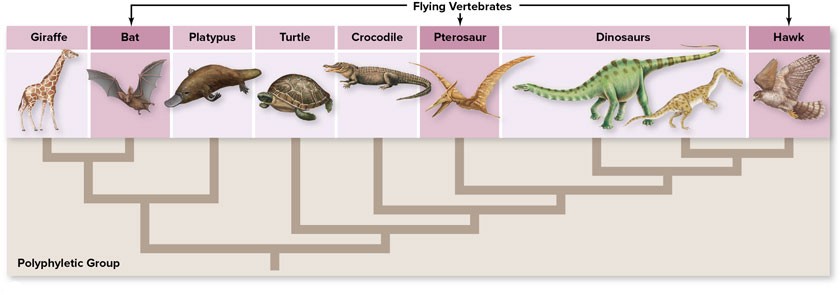 Based on the above diagram and other information from your text, what is the most likely (e.g., most parsimonious) explanation for the evolution of flight in vertebrates?
Based on the above diagram and other information from your text, what is the most likely (e.g., most parsimonious) explanation for the evolution of flight in vertebrates?
A. Wings evolved once in vertebrates (e.g., the common ancestor of all terrestrial vertebrates had wings), and wings were subsequently lost in all but three lineages: bats, pterosaurs, and birds.
B. The common ancestor of all terrestrial vertebrates was wingless, and wings evolved independently three different times: in bats, in pterosaurs and in the common ancestor of birds and dinosaurs.
C. The common ancestor of all terrestrial vertebrates was wingless, and wings evolved independently two different times: once in bats and once in the common ancestor of birds, pterosaurs, and dinosaurs.
D. The common ancestor of all terrestrial vertebrates was wingless, and wings evolved independently three different times: in bats, in pterosaurs, and in birds.
E. The common ancestor of all terrestrial vertebrates was wingless, and wings evolved independently three different times: in bats, in birds and in the common ancestor of pterosaurs and dinosaurs.
Answer: D
You might also like to view...
Which of these is not a type of water pollutant?
(a) dissolved oxygen. (b) toxic chemicals. (c) organic wastes. (d) sediment.
Identify the stage of mitosis in photo B
a. interphase b. prophase c. metaphase d. anaphase e. telophase
Birds in which the lower bill protrudes much farther than the upper bill are
a. jaegers. b. skimmers. c. puffins. d. penguins. e. herons.
An important function of nomenclature is to
A) facilitate unambiguous communication. B) clarify relationships among organisms. C) provide an understanding of evolutionary relationships. D) define the characteristics used for classification. E) provide a detailed description of an organism.